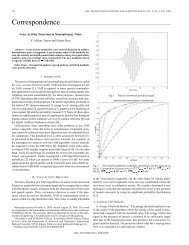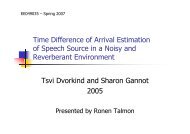Thesis (PDF) - Signal & Image Processing Lab
Thesis (PDF) - Signal & Image Processing Lab
Thesis (PDF) - Signal & Image Processing Lab
You also want an ePaper? Increase the reach of your titles
YUMPU automatically turns print PDFs into web optimized ePapers that Google loves.
64 CHAPTER 5. TREE SEMILATTICES<br />
section 2.1) within the tree t2, taken point-wise, that is:<br />
M1 �t2 M2 ⇐⇒ ∀x ∈ E, M1(x) �t2 M2(x). (5.2)<br />
An example of order of trees is shown in Figure 5.3.<br />
Proposition 1 (Tree order). The above tree relation is a partial ordering on T L<br />
r .<br />
Proof. Since both graph inclusion (⊆) and the intrinsic root tree partial ordering (�t2)<br />
are partial orderings, so is the composed relation on the tree representation.<br />
A relevant question at this point is what are the infimum and supremum operators<br />
related to the above partial ordering and whether they are well defined for any subset<br />
of tree representations. In other words, is (T L<br />
r , ≤) a lattice or a semilattice, and if so,<br />
complete or not?<br />
First notice that, for two graphs g1 and g2, the intersection g1 ∩ g2 is the in-<br />
fimum graph. However, if g1 and g2 are trees, then unfortunately g1 ∩ g2 is not<br />
necessarily a tree. This is because the resulting graph may be disconnected, in<br />
which case g1 ∩ g2 is a forrest, but not a tree. For instance, consider the two trees<br />
t1 = ({r, a, b, d}, {ra, ab, bd}) and t2 = ({r, a, c, d}, {ra, ac, cd}) as shown in Figure 5.4.<br />
(a) (b)<br />
Figure 5.3: An example of order of trees. The tree representation (a) is bigger than<br />
(b), because of two reasons: tree (b) is included in tree (a), and there exists pixels in<br />
(b) that belong to label 1, while the same pixels belong to labels 2 and 3 in (a).
















